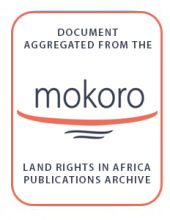Land Library
Welcome to the Land Portal Library. Explore our vast collection of open-access resources (over 74,000) including reports, journal articles, research papers, peer-reviewed publications, legal documents, videos and much more.
/ library resources
Showing items 1 through 9 of 57.Companies in the business of selling farmland to billionaires and pension funds are peddling it as a green;sustainable and socially responsible investment. This propaganda is working.
On 27 April 2021 President Kenyatta launched the National Land Information Management System (NLIMS);the culmination of years of digitisation of chaotic land records. It is expected to ease title transfers and safeguard public land from grabbers.
Land is a commodity like no other. We live on it;we grow from it;we drink from it and build our futures upon it. But we don’t share it equally. The distribution of land has long defined the gap between rich and poor.
From 2009-2015 Namati and partners CTV in Mozambique;LEMU in Uganda and SDI in Liberia supported more than 100 communities to document and protect their customary land rights.
Since the arrival of multinational agribusiness company SOCFIN in 2011 as part of a large-scale investment in palm oil in the Southern Province of Sierra Leone;social conflict has raged in the Malen Chiefdom.
This report denounces human rights violations occurring in Socfin Group’s rubber plantations operation in Liberia.
Money from pension funds has fuelled the financial sector’s massive move into farmland investing over the past decade. The number of pension funds involved in farmland investment and the amount of money they are deploying into it is increasing;under the radar.
Examines the political economy of agricultural commercialisation in Malawi over the past three decades;which has been influenced to a very large extent by the changing configurations of political elites and their underlying interests;incentives and motivations;including using the agricultural sec
GRAIN has documented at least 135 farmland deals for food crop production that have backfired between 2007 and 2017. They represent 17.5 million hectares. These are not failed land grabs, since the land almost never goes back to the communities, but failed agribusiness projects.

